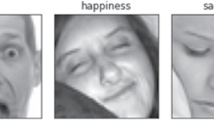Abstract
Facial expression offers an important way of detecting the affective state of a human being. It plays a major role in various fields such as the estimation of students’ attention level in online education, intelligent transportation systems and interactive games. This paper proposes a facial expression recognition system in which two channels of featured images are used to represent a 3D facial scan. Features are extracted from the local binary pattern and local directional pattern using a fine-tuned pre-trained AlexNet and a shallow convolutional neural network. The feature sets are then fused together using canonical correlation analysis. The fused feature set is fed into a multi-support vector machine (mSVM) classifier to classify the expressions into seven basic categories: anger, disgust, fear, happiness, neutral, sadness and surprise. Experiments were carried out on the Bosphorus database using tenfold cross-validation with mutually exclusive training and testing samples. The results show an average accuracy of 87.69% using an mSVM classifier with a polynomial kernel and demonstrate that the system performs better by characterizing the peculiarities in facial expressions than alternative state-of-the-art approaches.







Similar content being viewed by others
References
S. Berretti, A.D. Bimbo, P. Pala, B.B. Amor, M. Daoudi, A set of selected SIFT features for 3D facial expression recognition, in International Conference on Pattern Recognition (ICPR), pp. 4125–4128 (2010)
T.F. Cootes, G.J. Edwards, C.J. Taylor, Active appearance models. IEEE Trans. Pattern Anal. Mach. Intell. 23(6), 681–685 (2001)
T.F. Cootes, C.J. Taylor, D.H. Cooper, J. Graham, Active shape models: their training and application. Comput. Vis. Image Underst. 61(1), 38–59 (1995)
A. Jan, H. Ding, H. Meng, L. Chen, H. Li, Accurate facial parts localization and deep learning for 3D facial expression recognition, in 13th IEEE International Conference on Automatic Face & Gesture Recognition, pp. 466–472 (2018)
Y. Lei, M. Bennamoun, A. El-Sallam, An efficient 3D face recognition approach based on the fusion of novel local low-level features. Pattern Recognit. 46(1), 24–37 (2013)
H. Li, H. Ding, D. Huang, Y. Wang, X. Zhao, J.M. Morvan, L. Chen, An efficient multimodal 2D + 3D feature-based approach to automatic facial expression recognition. Comput. Vis. Image Underst. 140, 83–92 (2015)
H. Li, J. Sun, Z. Xu, L. Chen, Multimodal 2D+3D facial expression recognition with deep fusion convolutional neural network. IEEE Trans. Multimed. 19, 2816–2831 (2017)
X. Li, Q. Ruan, Y. Ming, 3D facial expression recognition based on basic geometric features, in IEEE 10th International Conference on Signal Processing (ICSP), pp. 1366–1369 (2010)
X. Li, Q. Ruan, Y. Ming, A remarkable standard for estimating the performance of 3D facial expression features. Neurocomputing 82, 99–108 (2012)
P. Michel, R. El Kaliouby, Real time facial expression recognition in video using support vector machines, in 5th International Conference on Multimodal interfaces (ICMI) (2003)
I. Mpiperis, S. Malassiotis, M.G. Strintzis, Bilinear models for 3-D face and facial expression recognition. IEEE Trans. Inf. Forensics Secur. 3(3), 498–511 (2008)
D. O’Shaughnessy, Recognition and processing of speech signals using neural networks. Circuits Syst. Signal Process. 1, 2 (2019). https://doi.org/10.1007/s00034-019-01081-6
A. Savran, N. Alyüz, H. Dibeklioğlu, O. Çeliktutan, B. Gökberk, B. Sankur, L. Akarun, Bosphorus database for 3D face analysis, in European workshop on Biometrics and Identity Management, pp. 47–56 (2008)
H. Soyel, H. Demirel, Facial expression recognition using 3D facial feature distances, in Proceedings of the International Conference on Image Analysis and Recognition, pp. 831–838 (2007)
Q.S. Sun, S.G. Zeng, Y. Liu, P.A. Heng, D.S. Xia, A new method of feature fusion and its application in image recognition. Pattern Recognit. 38, 2437–2448 (2005)
Y. Sun, X. Chen, M. Rosato, L. Yin, Tracking vertex flow and model adaptation for three-dimensional spatiotemporal face analysis. IEEE Trans. Syst. Man Cybernet. Part A Syst. Hum. 40(3), 461–474 (2010)
M. Taner Eskil, K.S. Benli, Facial expression recognition based on anatomy. Comput. Vis. Image Underst. 119, 1–14 (2014)
H. Tang, T. Huang, 3D facial expression recognition based on properties of line segments connecting facial feature points, in 8th IEEE International Conference on Automatic Face & Gesture Recognition, pp. 1–6 (2008)
Y.V. Venkatesh, A.A. Kassim, O.V. Ramana Murthy, A novel approach to classification of facial expressions from 3D-mesh datasets using modified PCA. Pattern Recognit. Lett. 30(12), 1128–1137 (2009)
J. Wang, L. Yin, X. Wei, Y. Sun, 3D facial expression recognition based on primitive surface feature distribution. IEEE Comput. Soc. Conf. Comput. Vis. Pattern Recognit. 2, 1399–1406 (2006)
Y. Wang, M. Gupta, S. Zhang, S. Wang, X. Gu, D. Samaras, P. Huang, High resolution tracking of non-rigid motion of densely sampled 3D data using harmonic maps. Int. J. Comput. Vis. 76(3), 283–300 (2008)
X. Yang, D. Huang, Y. Wang, L. Chen, Automatic 3D facial expression recognition using geometric scattering representation, in 11th IEEE International Conference and Workshops on Automatic Face and Gesture Recognition, pp. 1–6 (2015)
T. Yun, L. Guan, Human emotion recognition using real 3D visual features from Gabor library, in IEEE International Workshop on Multimedia Signal Processing (MMSP), pp. 505–510 (2010)
K. Yurtkan, H. Demirel, Feature selection for improved 3D facial expression recognition. Pattern Recognit. Lett. 38, 26–33 (2014)
X. Zhao, E. Dellandréa, J. Zou, L. Chen, A unified probabilistic framework for automatic 3D facial expression analysis based on a Bayesian belief inference and statistical feature models. Image Vis. Comput. 31(3), 231–245 (2013)
Z. Zeng, M. Pantic, G. Roisman, T. Huang, A survey of affect recognition methods: audio, visual, and spontaneous expressions. IEEE Trans. Pattern Anal. Mach. Intell. 31(1), 39–58 (2007)
L. Zhang, D. Tjondronegoro, Facial expression recognition using facial movement features. IEEE Trans. Affect. Comput. 2(4), 219–229 (2011). https://doi.org/10.1109/T-AFFC.2011
X. Zhou, H. Seibert, C. Busch, W. Funk, A 3D face recognition algorithm using histogram-based features, in Eurographics Workshop on 3D Object Retrieval (2008)
Author information
Authors and Affiliations
Corresponding author
Additional information
Publisher’s Note
Springer Nature remains neutral with regard to jurisdictional claims in published maps and institutional affiliations.
Rights and permissions
About this article
Cite this article
Ramya, R., Mala, K. & Selva Nidhyananthan, S. 3D Facial Expression Recognition Using Multi-channel Deep Learning Framework. Circuits Syst Signal Process 39, 789–804 (2020). https://doi.org/10.1007/s00034-019-01144-8
Received:
Revised:
Accepted:
Published:
Issue Date:
DOI: https://doi.org/10.1007/s00034-019-01144-8




